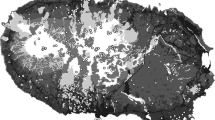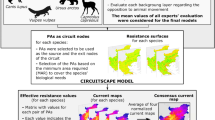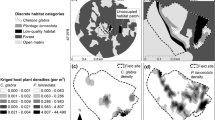Abstract
Landscape connectivity is a key process for the functioning and persistence of spatially-structured populations in fragmented landscapes. Butterflies are particularly sensitive to landscape change and are excellent model organisms to study landscape connectivity. Here, we infer functional connectivity from the assessment of the selection of different landscape elements in a highly fragmented landscape in the Île-de-France region (France). Firstly we measured the butterfly preferences of the Large White butterfly (Pieris brassicae) in different landscape elements using individual release experiments. Secondly, we used an inter-patch movement model based on butterfly choices to build the selection map of the landscape elements to moving butterflies. From this map, functional connectivity network of P. brassicae was modelled using landscape graph-based approach. In our study area, we identified nine components/groups of connected habitat patches, eight of them located in urbanized areas, whereas the last one covered the more rural areas. Eventually, we provided elements to validate the predictions of our model with independent experiments of mass release-recapture of butterflies. Our study shows (1) the efficiency of our inter-patch movement model based on species preferences in predicting complex ecological processes such as dispersal and (2) how inter-patch movement model results coupled to landscape graph can assess landscape functional connectivity at large spatial scales.






Similar content being viewed by others
References
Andersson E, Bodin O (2009) Practical tool for landscape planning? An empirical investigation of network based models of habitat fragmentation. Ecography 32:123–132
Baguette M, Van Dyck H (2007) Landscape connectivity and animal behavior: functional grain as a key determinant for dispersal. Landsc Ecol 22:1117–1129
Bergerot B, Julliard R, Baguette M (2010a) Metacommunity dynamics: decline of functional relationship along a habitat fragmentation gradient. PLoS ONE 5(6):e11294. doi:10.1371/journal.pone.0011294
Bergerot B, Fontaine B, Renard M, Cadi A, Julliard R (2010b) Preferences for exotic flowers do not promote urban life in butterflies. Landsc Urban Plan 96:98–107
Bergerot B, Merckx T, Van Dyck H, Baguette M (2012) Habitat fragmentation impacts mobility in a common and widespread woodland butterfly: do sexes respond differently? BMC Ecology 12(5). doi:10.1186/1472-6785-12-5
Bink BA (1992) Ecologische atlas van de Dagvlinders van Noordwest-Europa (Ecological Atlas of the Butterflies of NW Europe). Schuyt & Co, Haarlem
Bowne DR, Bowers MA (2004) Interpatch movements in spatially structured populations: a literature review. Landsc Ecol 19:1–20
Bunn AG, Urban DL, Keitt TH (2000) Landscape connectivity: a conservation application of graph theory. J Environ Manage 59:265–278
Clobert J, Danchin E, Dhont AA, Nichols JD (2001) Dispersal. Oxford University Press, New York
Clobert J, Le Gaillard JF, Cote J, Meylan S, Massot M (2009) Informed dispersal, heterogeneity in animal dispersal syndromes and the dynamics of spatially structured populations. Ecol Lett 12:197–209
Dennis RLH, Hardy PB (2007) Support for mending the matrix: resource seeking by butterflies in apparent non-resource zones. J Insect Conserv 11:157–168
ECOMOS (2003) Ecological Soil Occupation Mode. See: http://www.iau-idf.fr/lile-de-france/un-portrait-par-les-chiffres/occupation-du-sol.html
Fahrig L (2003) Effects of habitat fragmentation on biodiversity. Annu Rev Ecol Evol Syst 34:487–515
Fahrig L, Merriam G (1994) Conservation of fragmented populations. Conserv Biol 8:50–59
Fall A, Fortin MJ, Manseau M, O’Brien D (2007) Spatial graphs: principles and applications for habitat connectivity. Ecosystems 10:448–461
Feltwell J (1981) Large white butterfly: the biology, biochemistry, and physiology of Pieris Brassicae. DRW junk publishers, The Hague
Foltête J-C, Clauzel C, Vuidel G, Tournant P (2012) Integrating graph-based connectivity metrics into species distribution models. Landsc Ecol 27:557–559
Galpern P, Manseau M, Fall A (2011) Patch-based graphs of landscape connectivity: a guide to construction, analysis and application for conservation. Biol Conserv 144:44–55
Haddad NN (1999) Corridor and distance effects on interpatch movements: a landscape experiment with butterflies. Ecol Appl 9:612–622
Haddad NN, Tewksbury JJ (2005) Low-quality habitat corridors as movement conduits for two butterfly species. Ecol Appl 15:250–257
Hanski I (1999) Metapopulation ecology. Oxford University Press, New York
Laita A, KotiahoJ Mönkkönen M (2011) Graph-theoretic connectivity measures: what do they tell us about connectivity? Landsc Ecol 26:951–967
Lookingbill TR, Gardner RH, Ferrari JR, Keller CE (2010) Combining a dispersal model with network theory to assess habitat connectivity. Ecol Appl 20:427–441
Merckx T, Van Dyck H, Karlsson B, Leimar O (2003) The evolution of movements and behaviour at boundaries in different landscapes: a common arena experiment with butterflies. Proc R Soc B 270:1815–1821
Minor ES, Lookingbill TR (2010) A multiscale network analysis of protected-area connectivity for mammals in the United States. Conserv Biol 24:1549–1558
Morrison ML, Hall LS (2002) Standard terminology: toward a common language to advance ecological understanding and application. In: Scott JM, Heglund P, Morrisson ML, Raven PH (eds) Predicting species occurrences. Issues of accuracy and scale. Island Press, Washington, pp 43–52
Morzillo AT, Ferrari JR, Liu JG (2011) An integration of habitat evaluation, individual based modeling, and graph theory for a potential black bear population recovery in southeastern Texas, USA. Landsc Ecol 26:69–81
O’Brien D, Manseau M, Fall A, Fortin MJ (2006) Testing the importance of spatial configuration of winter habitat for woodland caribou: an application of graph theory. Biol Conserv 130:70–83
Ockinger E, Dannestam A, Smith HG (2009) The importance of fragmentation and habitat quality of urban grasslands for butterfly diversity. Landsc Urban Plan 93:31–37
Saura S, Pascual-Hortal L (2007) A new habitat availability index to integrate connectivity in landscape conservation planning: comparison with existing indices and application to a case study. Landsc Urban Plan 83:91–103
Schtickzelle N, Baguette M (2003) Behavioural responses to habitat patch boundaries restrict dispersal and generate emigration-patch area relationships in fragmented landscapes. J Anim Ecol 72:533–545
Spear SF, Balkenhol N, Fortin MJ, McRae BH, Scribner K (2010) Use of resistance surfaces for landscape genetic studies: considerations for parameterization and analysis. Mol Ecol 19:3576–3591
Stefanescu C, Herrando S, Paramo F (2004) Butterfly species richness in the north-west Mediterranean Basin: the role of natural and human-induced factors. J Biogeogr 31:905–915
Stevens VM, Verkenne C, Vandewoestijne S, Wesselingh RA, Baguette M (2006) Gene flow and functional connectivity in the natterjack toad. Mol Ecol 15:2333–2344
Stevens VM, Turlure C, Baguette M (2010) A meta-analysis of dispersal in butterflies. Biol Rev 85:625–642
Storfer A, Murphy MA, Spear SF, Holderegger R, Waits LP (2010) Landscape genetics: where are we now? Mol Ecol 19:3496–3514
Taylor PD, Farhig L, Henein K, Merriam G (1993) Connectivity is a vital element of landscape structure. Oikos 68:571–572
Thomas CD (2000) Dispersal and extinction in fragmented landscapes. Proc R Soc B 267:139–145
Turchin P (1998) Quantitative analysis of movement: measuring and modeling population redistribution in animals and plants. Sinauer Associates Inc, Sunderland
Urban D, Keitt T (2001) Landscape connectivity: a graph-theoretic perspective. Ecology 82:1205–1218
Urban D, Minor ES, Treml EA, Schick RS (2009) Graph models of habitat mosaics. Ecol Lett 12:260–273
Van Dyck H, Baguette M (2005) Dispersal behaviour in fragmented landscapes: routine or special movements? Basic Appl Ecol 6:535–545
Van Halder I, Barbaro L, Corcket E, Jactel H (2008) Importance of semi-natural habitats for the conservation of butterfly communities dominated by pine plantations. Biodivers Conserv 5:1149–1169
Wilcove DS, McLellan CH, Dobson AP (1986) Habitat fragmentation in the temperate zone. In: Soulé ME (ed) Conservation biology: the science of scarcity and diversity. Sinauer Assoc, Sunderland, pp 237–256
Acknowledgments
We particularly thank volunteers for their observation and participation to the study and Natureparif, Audrey Coulon for the caterpillars rearing, Leyli Borner and all the Evoltrait team based in Brunoy for their support and useful help in this study. We especially thank the two anonymous reviewers whose comments greatly improved this manuscript. MB’s contribution was funded by a grant from the ANR (Agence Nationale de la Recherche, Open Call DIAME 2008-2011 DIspersal And MEtapopulations). This project was supported by the SCALE project. The graph analysis was conducted in the framework of the Graphab project of the USR 3124 MSHE Ledoux, funded by the French Ministry of Ecology, Energy, Sustainable Development and Sea.
Author information
Authors and Affiliations
Corresponding author
Rights and permissions
About this article
Cite this article
Bergerot, B., Tournant, P., Moussus, JP. et al. Coupling inter-patch movement models and landscape graph to assess functional connectivity. Popul Ecol 55, 193–203 (2013). https://doi.org/10.1007/s10144-012-0349-y
Received:
Accepted:
Published:
Issue Date:
DOI: https://doi.org/10.1007/s10144-012-0349-y




